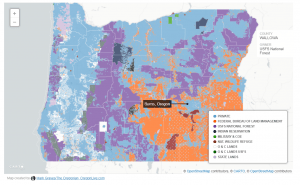Public Land Hunting Access
Overview
Oregon boasts 53% public land, and a lot of it is huntable. That said, a lot of this public land is not quality big game habitat, so savvy hunters know not only where they can access, but also where is worth accessing. Here are some tips public land hunting in Oregon.
Know Your Government Lands
When hunters say “public land”, they generally mean land that is owned by some form of federal, state, or local government. There are countless categories of public lands out there, so hunters are responsible for knowing what land they are accessing and whether or not hunting is allowed on that site.
Federal Public Land
Much of Oregon is owned by United States government agencies. US Department of the Interior is responsible for managing federal public lands, and in this article they do a great job explaining America’s public lands. Oddly, there is no mention Bureau of Land Management (BLM) lands as a stand-alone category. BLM sites are fantastic hunting opportunities in Oregon, especially for upland game but in some areas for big game as well.
Because we as citizens own public lands, governments provide a range of outdoor recreation opportunities such as hunting, fishing, hiking, camping, and so on. Be mindful that recreation types vary wildly from site to site, so it’s best to do your homework before trying to hunt on a specific area of public land. Start with online research, but it’s also helpful to visit or call the office that administrates a particular public property — or even visit the site yourself. You’ll often find signs posted site headquarters that indicate whether hunting is allowed or not. Sometimes there are fees to access. Other times access is completely free.
End of day, public lands are a national treasure and fantastic opportunity for hunters. To keep things this way, make sure to research the area you are hunting and follow all site-specific guidelines.

State Public Land
The Oregon Department of State Lands provides a GIS inventory of all state-owned lands. The interactive State Land Inventory Map is a great place to check for potential public access in your area, but as with federal public lands, hunters need to know whether hunting is allowed on a particular parcel of state land.
Oregon has nineteen state Wildlife Areas that are intensively managed for hunting, wildlife viewing, or both. Check out this information sheet at MyODFW.com to learn more about hunting on wildlife areas.
PRO TIP A parking pass is required on all state-owned Wildlife Areas. A free parking pass comes with every hunting license, but make sure to leave this pass on your dashboard when hunting at the wildlife areas.
Local Public Land
In raw acreage, local public land pales in comparison to the state and federal parcels. But they can offer micro-hunting spots in cases where local municipalities allow hunting. Maps and resources are few, so some personal due diligence and scouting are necessary to figure out if a local public land might offer a spot to hang your tree stand and deer hunt.
Public Access on Private Land
Oregon offers a good bit of public hunting access on private land. There are dozens of programs and properties available — and they are constantly changing — so learning the access ropes on these sites can take many years to fully master. Typically, these properties are industrial timber sites or rangeland in Eastern Oregon. This ODFW site lists many hunting areas and maps that will get you started learning where and when you can hunt on private lands.